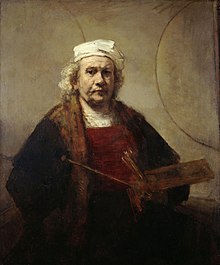Potret diri
Potret diri atau swapotret adalah sebuah perwakilan dari seorang seniman yang menggambar, melukis, memfoto, atau memahat karya tersebut. Meskipun potret diri telah dibuat sejak masa-masa awal, para seniman baru giat menggambar dirinya sendiri sebagai subyek utama atau karakter menonjol dalam karya mereka pada zaman Renaisans Awal pada pertengahan abad ke-15.

Lihat pula
sunting- Swafoto atau foto diri sendiri
Catatan dan referensi
sunting- ^ Chapman, H. Perry: Rembrandt's Self-Portraits: A Study Seventeenth-Century Identity. (Princeton, N.J.: Princeton University Press, 1990)
- ^ Cumming, Laura: A Face to the World: On Self-Portraits. (London: HarperPress, 2009, ISBN 9780007118434)
- ^ Gottwald, Franziska: Das Tronie. Muster—Studie—Meisterwerk: Die Genese einer Gattung der Malerei vom 15. Jahrhundert bis zu Rembrandt [Kunstwissenschaftliche Studien, Band 164]. (Berlin: Deutscher Kunstverlag, 2011)
- ^ Hall, James: The Self-Portrait: A Cultural History. (London: Thames & Hudson, 2014)
- ^ Rubiś, Wojciech; Tendera, Paulina (2014), 'Artistic Thinking – Thinking of the Essence (the Self-portraits of Rembrandt van Rijn)'. Estetyka i Krytyka 34(3): 101–118
- ^ Lecoq-Ramond, Sylvie; Paccoud, Stéphane; Schäfer, Dorit (eds.): Autoportraits: de Rembrandt au selfie [exh. cat.]. (Lyon: Musée des Beaux-Arts de Lyon; Köln: Snoeck, 2015)
- ^ Hall, James; Vaisse, Pierre; Ullrich, Wolfgang; et al. (eds.): Facing the World: Self-portraits from Rembrandt to Ai Weiwei [exh. cat.]. (Edinburgh: Scottish National Galleries; Köln: Snoeck, 2016)
Bacaan tambahan
sunting- John J. Ciofalo, Self-Portraits of Francisco Goya. Cambridge University Press, 2001
- Edward Lucie-Smith with Sean Kelly, The Self Portrait: A Modern View. (1987)
- Ernst van de Wetering and others; Rembrandt by himself, 1999, National Gallery, London / Mauritshuis, The Hague, ISBN 1-85709-270-8
- Joseph Leo Koerner, The Moment of Self-Portraiture in German Renaissance Art, Chicago/London, 1993
- Jonathan Miller, On Reflection, 1998, National Gallery, ISBN 1-85709-237-6.
- Joanna Woodall, Self Portrait. Renaissance to Contemporary. National Portrait Gallery, London and Art Gallery of New South Wales, Sydney, 2005.
- Belle, Julian (Ed.): Five Hundred Self-Portraits. Phaidon Press, London/New York, 2000 (pb 2004), ISBN 0-7148-4384-9 Self-Portraits in chronological order from ancient Egypt to the present.
Tidak dalam bahasa Inggris
sunting- Joëlle Moulin, L'autoportrait au XXe siècle, éd. Adam Biro, Paris, 1999
- Pascal Bonafoux, Les peintres et l'autoportrait, 1984
- Bernard Auriol, L'image préalable, l'expression impressive et l'autoportrait, Psychologie Médicale, 19, 9, 1543–1547, 1987 {available on line : self-portrait}
- Bonafoux, Pascal / Rosenberg, David: Moi! Autoportraits du XXe siècle. Musée du Luxembourg (Paris) / Skira Editore (Milano), Exhibition catalogue. 2004, Text French, Paris 2004, ISBN 88-8491-854-5 The book presents 155 artist (fine art) of the 20th century by showing their self-portraits added by informative texts.
- Borzello, Frances: Wie Frauen sich sehen – Selbstbildnisse aus fünf Jahrhunderten. Karl Blessing Verlag, München 1998, ISBN 3-89667-052-2
- Calabrese, Omar: Die Geschichte des Selbstporträts. Deutscher Kunstverlag, München 2006, ISBN 3-7774-2955-4
- Pfisterer, Ulrich / Rosen, Valeska von ~ (Hrsg.): Der Künstler als Kunstwerk. Selbstporträts vom Mittelalter bis zur Gegenwart. Reclam, Stuttgart 2005, ISBN 3-15-010571-4 (Rezension)
- Jeancolas, Claude. (1998). Passion Rimbaud: L'Album d'une vie. (Prancis) Paris: Textuel. ISBN 978-2-909317-66-3
- Kathrin Schmidt: Annegret Soltau: ich selbst, Mathildenhöhe Darmstadt (Germany), 2006 ISBN 3-935062-06-0
Self-portrait in neurology
sunting- Tielsch AH, Allen PJ (2005) Listen to them draw: screening children in primary care through the use of human figure drawings. Pediatr Nurs 31(4): 320–327. This survey of literature is focused on the method of drawing people as the method of diagnostics. Children's figures can recognize mental disorders. The authors describe the use of self-portraits for diagnostics of emotional disorders in children from 6 to 12 years. Although this procedure does not make it possible to place final diagnosis, it is useful for the recognition of problems.
- Morin C, Pradat-Diehl P, Robain G, Bensalah Y, Perrigot M (2003) Stroke hemiplegia and specular image: lessons from self-portraits. Int J Aging Hum Dev 56(1): 1-41. Patients with hemiplegia have diverse problems of self-perception, which are caused by neurological defeats of the idea of body, or by psychological problems with the perception their own self.
Psikologi persepsi diri
sunting- Wegner DM (2003) The mind's self-portrait. Ann N Y Acad Sci 1001: 212–225. Psychology and neuroscience approach understanding of reason and consciousness. Meanwhile, each human reason contains the self-portrait, which contains the self-appraisal of cognitive processes. This self-portrait assumes that the actions of man are governed by thoughts and, thus, the body is governed by consciousness. Self-portrait leads to the persuasion, that we consciously desire to make something. Studies show that self-portraiture is a caricature on the function of the brain, but at the same time it is the basis of the sensation of authorship and responsibility of one's own actions.
Pranala luar
suntingWikimedia Commons memiliki media mengenai self-portraits.
- National Portrait Gallery – Official web site
- "The Exploration of Self: What Artists Find When They Search in the Mirror" by Jeanne Ivy.
- UMBC, research related to The Self Portrait: A Modern View. (1987), Edward Lucie-Smith with Sean Kelly and other books
- 52 self-portraits from the National Galleries of Scotland
- Catalogue of self portraits by the Royal Society of Portrait Painters 2007